Public Pier — No Fishing License Required
San Francisco seems to have both an image and persistent vitality that exit alongside, or perhaps in spite of, the changes that have taken place in the name of progress. Witness this pier. It is one of the most beautiful piers in the state and it was planned that way. It is designed to serve both fisherman and tourists and its architecture brings back images of a different Victorian Age. Its backdrop is a pyramid, the Transamerica Pyramid (which combines the best of Ancient Egypt and modern capitalism). The pier itself reflects an attempt to do two things: achieve open-space recreational land use and keep alive, or perhaps even embellish, the city’s history.
Although this pier was dedicated in October 1990, a Pier 7 has existed at this spot since 1901. The original pier was the oldest structure on the waterfront and was initially used as a terminal for passenger vessels. Later, it was used for cargo storage, and even later (after a 1973 fire), it was used for parking — and fishing. The pier was damaged in the October 1989 Loma Prieta earthquake and its usefulness was at an end. Both Pier 7 and the adjacent Pier 5 were demolished and removed.
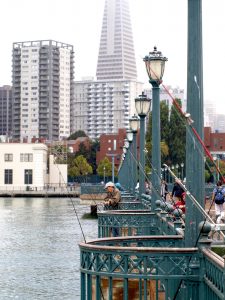
However, the fishing that had taken place on the old wharf was not forgotten. Public access was increasingly a topic for conversation and people began to discuss the idea for a recreational fishing pier, a public pier open to all. Luckily, in a town where it’s often almost impossible to get consensus on projects, enough people came to agreement to move the project forward.
As usual, funding for the project was a main question. How do we pay for it? But where there’s a will there’s a way. The San Francisco Department of Recreation and Parks, the Port of San Francisco, the State Wildlife Conservation Board (California Department of Fish & Game), the Land and Water Conservation Fund (National Park Service), the California State Coastal Conservancy and a State Block Grant together funded the $6,568,581 to build the pier. Striving for both utility and beauty, the pier included timber decking, ornamental iron handrails, antique-style iron and wooden benches, and Embarcadero light fixtures. The result was a beautiful fishing pier, one of the finest in the Bay Area (even though time and misuse by many has now taken its toll on the pier).
Environment. The pier, also called by some the “Broadway Pier” since it juts out into the bay just down the Embarcadero from Broadway is, at 840 feet in length, the second longest fishing pier in San Francisco. It extends out into water that is 35 feet deep, fairly deep water for Bay Area piers. It is reputedly one of the best fishing spots along the waterfront and yields both quality and quantity rare to most of the bay piers.
The bottom is primarily mud but there is a lot of tackle-snagging debris on the bottom, especially on the sides of the pier. Even though this can result in a loss of tackle, it can also be good for the fishing since the debris attracts small fish like midshipman and other small bottom dwellers that, in turn, attract larger fish. This debris may in part be the pilings from the old Pier 7, which, although supposedly removed, undoubtedly were broken off in many cases.
The pier has concrete pilings that have some barnacle growth to attract the fish. Inshore, along the entrance to the pier, there is some older growth along the edge of the water. Inshore, and around the pilings themselves, are the best areas for several varieties of seaperch. Out toward the end, in deeper water is the best angling for sharks, bat rays, skates, tomcod, white croaker (kingfish), jacksmelt, flounder, sole, sanddabs, halibut and striped bass.
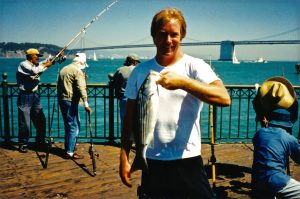
Striped Bass — 1998
The human element at this pier is also fascinating, a kaleidoscope of races, cultures and classes which few piers can match. Fishermen are a mixed group, primarily Chinese, but also Filipino, Latino, African-American, Caucasian, and just about any other group you may want to see (although I have not, as yet, spotted a non-tellurian). The language, the foods they bring to the pier, the fishing techniques and the cultures intermix in a manner that seems to work since it’s a friendly, help-each-other kind of a place. Most of the anglers are locals and most, I guess, are retired. But the pier sits next to the City’s financial district. Most lunch hours will see a few young executives, and executive wannabes (or soontobes) out on the pier. Perhaps there is only time for a short walk out to the end, time to discuss the latest business campaign or office gossip, perhaps there is a more leisurely visit, time to relax from the pressures of the job. Often these visitors seem somewhat perplexed when a fish is caught. What is it? Is it safe to eat? Others show by their words and looks that they wished they were fishing, instead of working the old nine to five.
One visit to the pier saw me arrive just as workers were removing cameras, lighting equipment, dressing trailers, and a large table of fruit. Turned out they had been shooting a commercial (and I’ve seen this pier in more commercials—and Nash Bridges T.V. episodes (when the show was playing)—than any other northern California pier). Looked like it might be an interesting day and it was! Turns out the jacksmelt had also decided to visit the pier. Not the teeny weenie, Lilliputian-sized jacksmelt like you sometimes see in the south. NO, these were monster jacksmelt that thought they were trout. The 16” and 17” fish would grab a hook, imitate the Kilkenny cats as they fought all the way to the pier, and occasionally they would do a steelhead-imitatin’ jump out of the water. I was using a light tackle outfit rigged with two hooks and soon approached a state of nirvana.
After one particularly large fish, I noticed what appeared to be a young Chinese man and woman standing nearby. They were nicely dressed, he in a casual suit, she in a pretty dress. I mistook them for business people taking a break—until they approached me. In a strong British accent they asked, “what are you catching?” It turned out they were tourists from London and on their first visit to San Francisco. What a lovely town and oh what beautiful weather. So unlike London’s overcast sky (and I must admit that the shirt-sleeve weather was pretty nice, even if I knew it was a very untypical mid-July day). By the way, could they catch a fish? They had never been fishing and thought it would be so much fun. No problem! Soon I hooked two jacksmelt, handed the pole to the lady, and she reeled in the fish. A proud picture was taken of her with her two fish. Next, a single, but larger, fish was hooked. Now the man reeled in the fish. He bragged that his was larger; she bragged that she caught two at a time, and it was picture time once again. Instant, successful, fisherpeople. But, I cautioned them, it isn’t always so easy. We quickly had become friends and they assured me that upon return to Britain they intended to give fishing another whirl. Such is life at this pier in the city that Herb Caen liked to call Baghdad-by-the-Bay. A never-ending panorama of people and stories.
Fishing Tips. During the winter and spring, try for starry flounder out in the deeper water, or fish inshore and around the pilings for black seaperch, striped seaperch, rubberlip seaperch and pileperch. The best baits for the perch will be pile worms, mussels, small pieces of market shrimp or live grass shrimp fished on a high/low leader with a size 6 hook. Use grass shrimp and a live bait leader for the starry flounder.
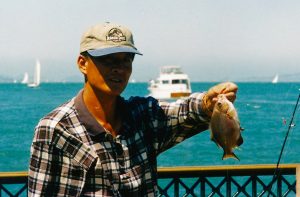
Striped Search — 1998
Summer and fall are good for sharks, kingfish and crabs. Large leopard sharks (I’ve seen as many as a dozen 40+inch leopards laying out at the end at one time), brown smoothhound sharks, bat rays (stingray) and skates hit best out at the end in deeper water. Most of the biggest sharks I’ve seen were taken from the right corner of the end but the tidal conditions help determine where the fish are, and some big fish are caught at almost every part of the end section. Use strong line and size 2/0 to 4/0 hooks. For bait, use squid, anchovy or live bait (shinerperch, staghorn sculpin or midshipmen); fish these on the bottom.
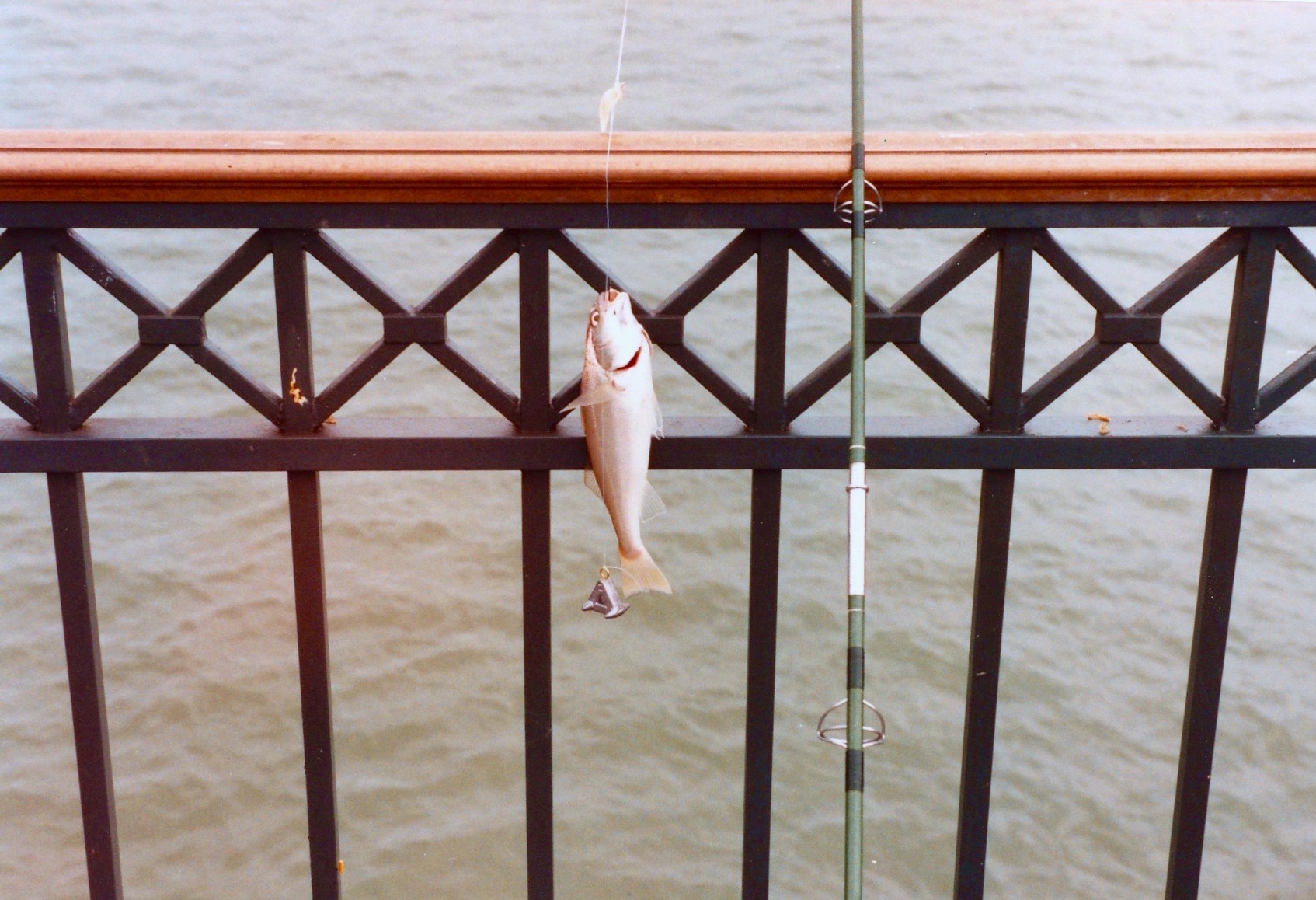
White croaker aka kingfish — 1991
White croaker (kingfish) prefer small pieces of anchovy; tomcod like small pieces of anchovy or pile worm. Sole and sanddabs on the bottom will hit either of these.
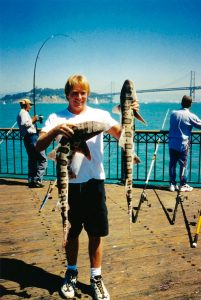
Leopard Sharks — 1998
Much of the year will also see schools of jacksmelt swing by the pier. When they do, a multi-hook leader rigged with small pieces of pile worm, shrimp or even anchovy will attract these large smelt. Remember to keep the leader just under the surface of the water by use of a large bobber, piece of Styrofoam or similar float.
Summer and fall can see halibut (mostly keeper-size for some reason); while August through September will sometimes see lots of striped bass. Most of these will be caught on frozen anchovies fished on the bottom or on live baits such as shinerperch and small smelt. However, during the summer months it is often easy to snag live (northern) anchovies at the pier and these are the TOP bait to use for the halibut. A Sabiki-type bait rig with small hooks (size 10-14) can sometimes yield three anchovies on every drop and these can be kept alive with a bucket and aerator. Although the schools of anchovies (and sometimes sardines) will move around depending upon the tide, the best spots for jigging baitfish seems to be along the sides of the pier just before you get to the end (before the pier widens). Fall months will also at times see some salmon landed, typically on an anchovy fished under a float. Although rare, it’s possible to hit a hat trick at the pier—striper, salmon and halibut all on the same day.
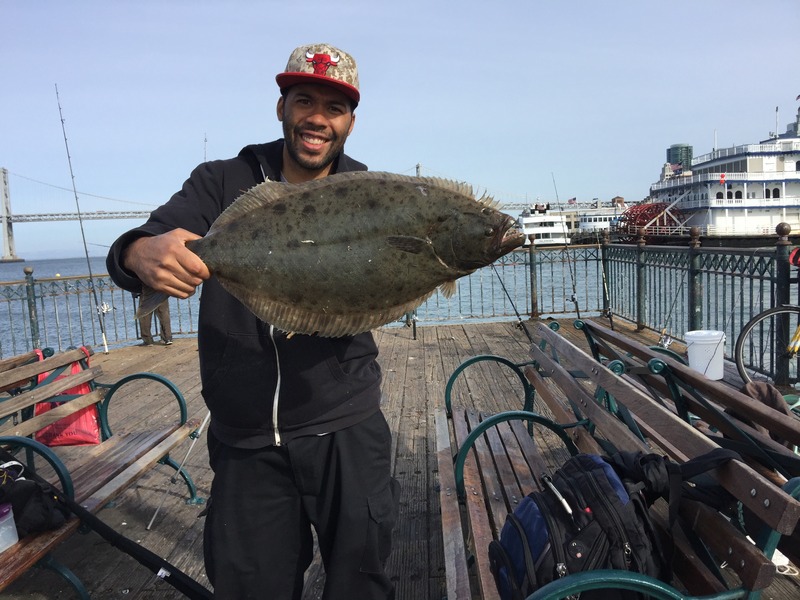
California Halibut — 2018
Often during the summer nearly as many anglers are crabbing as fishing (although many people do both). This is an excellent area for rock crabs but remember that they are far tastier in the winter months. Also remember that if you pull up a Dungeness crab, no matter the size or season, they are illegal in the bay.
Warning — The currents here can at time be atrocious. I’ve had reports of people needing to use 12-ounce triangle sinkers to hold bottom. Such tidal action can happen at almost any of the Bay Area piers that front deeper water.
Warning — At times when baitfish such as anchovies or sardines (summer) or herring (winter) are hanging around the pier’s waters, you may also see a lot of birds. Pelicans dive bombing for fish or cormorants swimming in the water grabbing fish can be interesting, but can also lead to birds that are sometimes aggressive as well as birds that sometimes get caught in lines or even on hooks. If you do get one entangled in your line, reel it in, use a towel to cover its head, and remove the line and any hooks. A towel will provide a little safety both for you and the bird.
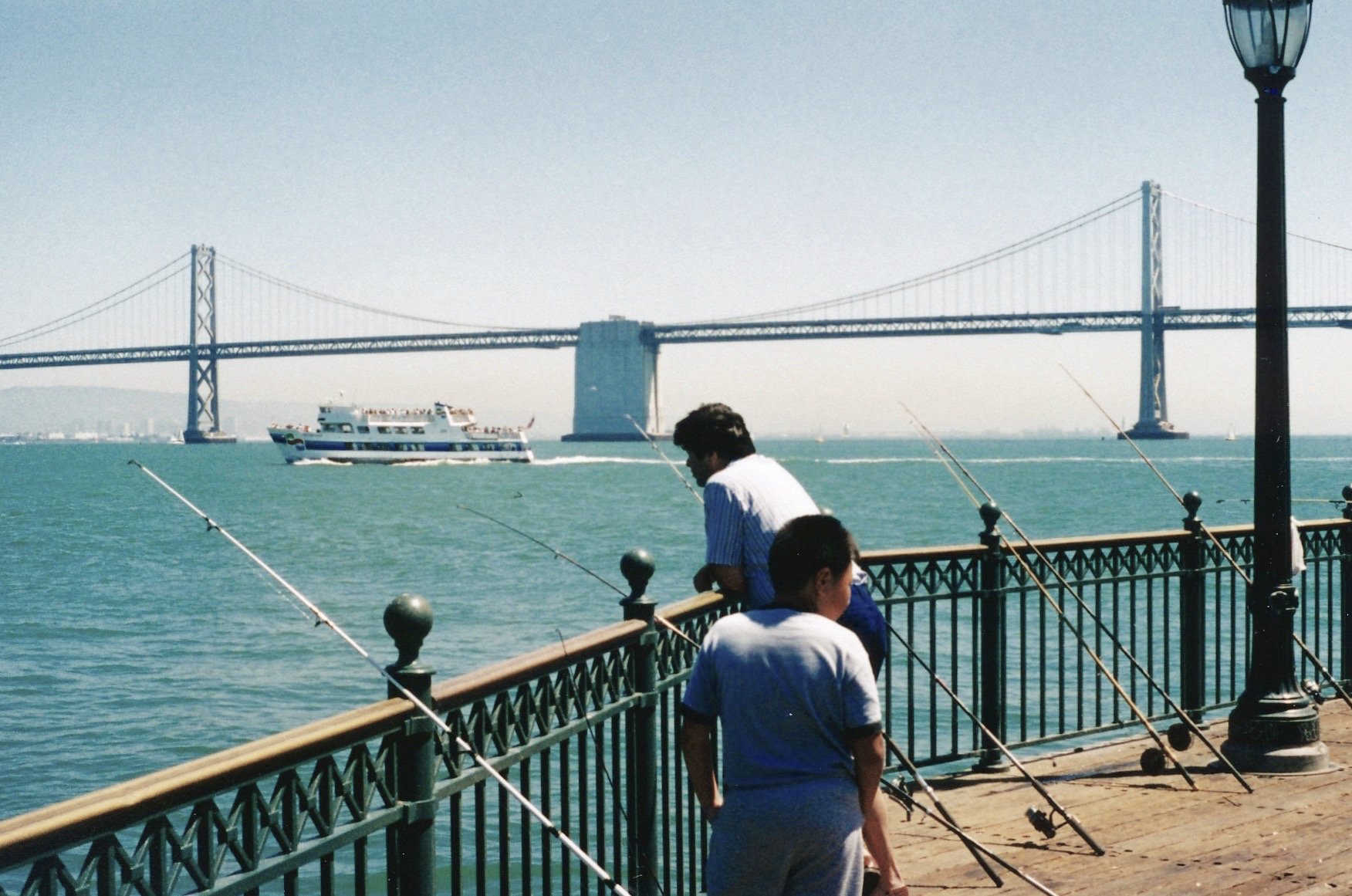
Fishing rods lined the railing in this picture from 1998
Potpourri — Perhaps More Than You Want To Know About Pier 7
<*}}}}}}}}}>< — This pier seems to be one of the favorite destinations for members of the San Francisco Police Fishing Program. One morning I witnessed a young man pull up to the pier in a van and soon he was unloading numerous rods and reels. By the time he finished, there were a couple of dozen outfits and my interest was piqued. A short conversation revealed that they would be used by a group of youngsters from the police fishing program. Shortly thereafter, additional officers arrived as did a number of kids who were soon happily fishing on the pier. Since some of these children had never fished before in their lives, it was a far bigger event in importance than that of the average angler out on the pier. They didn’t do great, but they did catch a few fish, and all seemed to have a great time.
This program also takes these kids out salmon fishing on the party boats, but wherever and whatever the type of fishing, I think it is a great program and one that should be duplicated by more communities. Teach the kids the beauty of nature and establish the rapport which is too often lacking in today’s world.
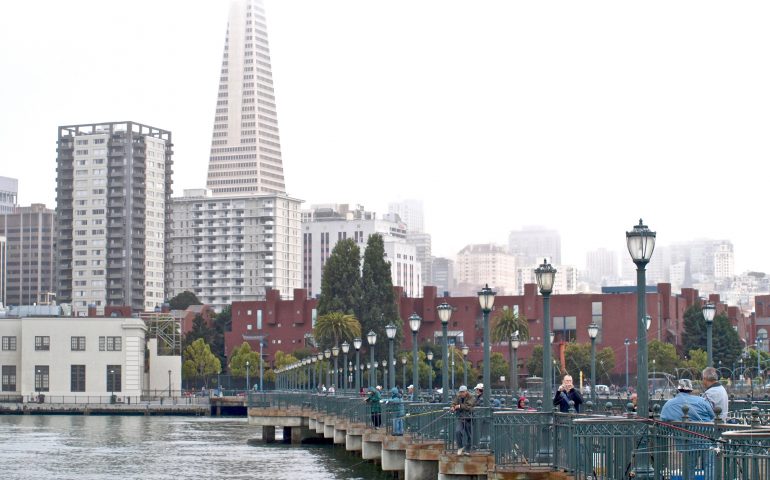
[…] Pier 7 – San Francisco […]
Both achieving open-space recreational land usage and preserving—or perhaps enhancing—the city’s heritage are reflected in the pier itself.
I’m coming back to San francisco next year in November want to fish pier 7 what all do I need to do and is there a bait shop close
Both achieving open-space recreational land usage and preserving